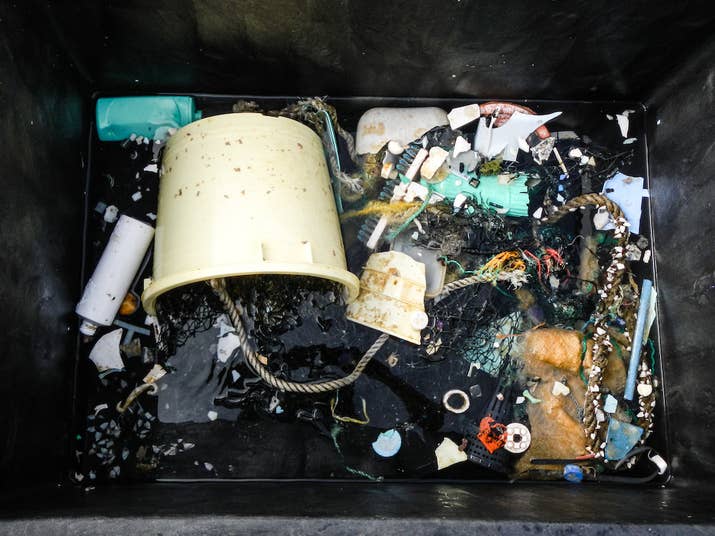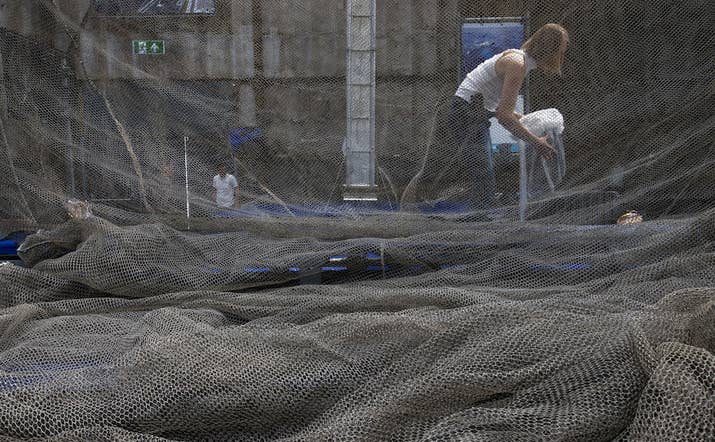IF
Would the world be better off if money didn't exist?
Posted by What.If on Friday, March 23, 2018
Read About The Tarbaby Story under the Category: About the Tarbaby Blog
Would the world be better off if money didn't exist?
Posted by What.If on Friday, March 23, 2018
By Brian Naylor March 23, 2018
 The U.S. government says Russian government hackers have targeted and gained access to U.S energy computer networks. Rich Pedroncelli/AP
The U.S. government says Russian government hackers have targeted and gained access to U.S energy computer networks. Rich Pedroncelli/AP
When President Trump phoned Russian President Vladimir Putin to congratulate him on his re-election Wednesday, Trump made no mention of one of the latest irritants between Russia and the West — his administration’s announcement that Russia successfully hacked the U.S. power grid.
The Department of Homeland Security and the FBI issued a joint alert last week: “Russian government cyber actors” have been targeting U.S. critical infrastructure sectors, including energy, nuclear and commercial facilities, since at least March 2016.
The announcement came the same day that the U.S. imposed sanctions against 19 Russian individuals and five entities for interfering in the 2016 election and for other cyber-intrusions.
James Lewis, a cybersecurity expert and vice president of the Center for Strategic and International Studies, said the news that Russia penetrated the energy grid does not exactly come as a surprise.
“The Russians have been doing this for years,” Lewis said. “The change is that the U.S. government came out and said the Russians hacked the utilities.”
The government informed electric companies last summer that Russia undertook what DHS calls a “multistage intrusion campaign” against the utilities, using common hacking techniques such as malware and spear-phishing. The hackers were able to gain access to at least one power plant’s control system.
 The Department of Homeland Security was able to reconstruct screenshot fragments of a human machine interface that was accessed. US-CERT/Department of Homeland Security
The Department of Homeland Security was able to reconstruct screenshot fragments of a human machine interface that was accessed. US-CERT/Department of Homeland Security
“They were not simply looking around that system and reconnoitering it,” Joel Brenner, head of counterintelligence under the Director of National Intelligence in the Obama administration, told NPR. “They were placing the tools that they would have to place in order to turn off the power. That’s a serious vulnerability for us, and we’re not anywhere near ready to deal with it.”
The Russians have targeted other countries’ electrical grids, most notably Ukraine in 2015, disrupting power for more than 200,000 people.
Scott Aaronson, vice president of security and preparedness at the Edison Electric Institute, which represents the nation’s electric companies, said U.S. power companies have tried to learn from that attack.
Can Americans feel confident the U.S. grid is protected?
“Very much so,” Aaronson said. “The electric power sector takes a lot of different measures to protect our systems.”
That includes operating power plants without digital controls, just like in the old days, he said.
“I tell people one of the best ways to protect against a cyberthreat is to not rely on cyber assets,” Aaronson said, adding that the U.S. power grid “operated for the better part of the last century” without digital controls.
He also said utilities can “go back to a less-efficient means of operating but still keep the lights on.”
Some power companies also block emails and other Internet traffic from outside the country.
But protecting the grid is complicated because of its decentralized nature, with public utility commissions in 50 states exercising some control.
Critics say the Trump administration needs to take stronger steps to block these kinds of attacks from Russia. At a hearing Tuesday, Sen. Maria Cantwell, D-Wash., called the DHS alert a siren.
“Our energy infrastructure is under attack,” Cantwell said. “It’s under cyberattack, and we need to do much more to protect it as a national critical asset.”
Cantwell wants the Trump administration to do an assessment of Russian cyberattacks against the electric grid. The Department of Energy is establishing an Office of Cybersecurity, Energy Security, and Emergency Response, which will focus on energy infrastructure security.
But any retaliation in response to Russia’s cyber-incursion would be up to Trump.
But, as Brenner points out: “The president has not so far shown any inclination or any backbone in confronting repeated Russian provocations. And one can only ask why that is.”
Brenner added that Putin is “playing jiu-jitsu with us.”
“Nobody wants a war,” he said, adding the hostilities taking place now “are in the gray space between war and peace.”
CSIS’ Lewis said that absent a strong U.S. response to the Russian cyber-incursions though, Russia is likely to continue its behavior.
“The problem here is if we don’t give the Russians the idea that doing something to us is bad, they may be tempted to do it,” Lewis said.
And while sanctions can function as somewhat of a deterrent to further intrusions, they may not be enough.
The wealthy corporations and billionaires behind Janus v. AFSCME are pushing a dangerous right-to-work agenda that has its roots in the Jim Crow South.
The False Slogan: Racist Roots of Right-To-Work
The wealthy corporations and billionaires behind Janus v. AFSCME are pushing a dangerous right-to-work agenda that has its roots in the Jim Crow South of the 1940s. Vance Muse, who invented right to work, once told a U.S. Senate committee, “I am a Southerner and I am for white supremacy.”Read more: https://afscme.org/racist-roots
Posted by AFSCME on Tuesday, March 20, 2018
Valerie Volcovici March 20, 2018
WASHINGTON (Reuters) – The U.S. Bureau of Land Management on Tuesday auctioned off more than 51,000 acres (21,000 hectares) in southeastern Utah for oil and gas development, a sign of strong industry demand in a region conservationists have vowed to protect.
 Wind Whistle Rock, in the northeast section of the Bears Ears region. Photo by Tim D. Peterson.
Wind Whistle Rock, in the northeast section of the Bears Ears region. Photo by Tim D. Peterson.
The Utah lease sale included terrain near the former boundaries of the Bears Ears National Monument, whose size was scaled back by the Trump administration last year, as well as the Hovenweep and Canyons of the Ancients monuments, according to the bureau.
Results of the online auction, posted on Tuesday afternoon, showed that all 43 parcels up for sale received winning bids, which averaged $28.68 per acre and ranged between $2 and $93 per acre. Total proceeds from the auction were $1.56 million, according to the BLM.
“This means drilling in these parcels poses a more serious and immediate threat to the landscape and archaeological resources,” Aaron Weiss, media director for the Center for Western Priorities, said about the apparent strong demand.
The Monticello area received some of the highest bids, with Context Energy LLC bidding $145,600 for a 1,600-acre parcel, according to the BLM. Other bidders included Ayers Energy LLC, Wasatch Energy LLC and Kirkwood Oil and Gas Inc, according to the data.
The auction comes as the administration of President Donald Trump seeks to boost domestic energy production by expanding federal leasing and rolling back land protections.
Local officials have been eager to open up the areas, administered by the BLM, saying resource extraction is one of few economic opportunities for rural San Juan county, one of Utah’s poorest areas.
“Oil and gas operations are an important contributor to a diversified county economy and the county supports leasing as a necessary step toward realizing economic benefits,” county planner Nick Sanberg said in comments to the BLM.
 Along Comb Ridge, a 120-mile-long sandstone fold running through the southwest section of Bears Ears. Photo by Tim D. Peterson/LightHawk.
Along Comb Ridge, a 120-mile-long sandstone fold running through the southwest section of Bears Ears. Photo by Tim D. Peterson/LightHawk.
But conservation groups fumed, threatening lawsuits.
“We won’t sit idly by while President Trump and Interior Secretary (Ryan) Zinke auction off America’s cultural and public lands heritage to the oil and gas industry,” said Stephen Bloch, legal director with the Southern Utah Wilderness Alliance. The alliance argued that the BLM did not adequately study potential impacts on wilderness and cultural sites.
Southeastern Utah’s dramatic landscapes are rich in Native American artifacts, historical sites and dinosaur fossils.
A 360 acre-parcel near Bears Ears received a winning bid of $28 per acre, while 13 parcels near the nearby Hovenweep monument sold at an average of $29 per acre. A bid of $7 per acre won a 965-acre parcel next to Canyons of the Ancients National Monument.
The results were more competitive than those of a lease sale last week in which a 200-acre parcel near the Upper Missouri River Breaks National Monument sold for the minimum $2 per acre.
Zinke this month deferred or scaled back two other lease sales near archaeological and tourist sites in New Mexico and his home state of Montana amid local outcry and opposition from state lawmakers.
The BLM was not immediately available for comment but said it would post results of the sale, including names of winning bidders, by Wednesday morning.
Other recent lease sales have yielded relatively low bids, a reflection of soft demand for federal property as the oil and gas industry taps vast reserves on private lands.
Reporting by Valerie Volcovici; editing by Richard Valdmanis, David Gregorio and Leslie Adler
Our Standards:The Thomson Reuters Trust Principles.
Michelle Broder, BuzzFeed Reporter March 22, 2018.
The giant floating mass of plastic and other debris in the Pacific Ocean is now three times the size of France and growing exponentially, scientists warned in a new report Thursday.
 The Ocean Cleanup
The Ocean Cleanup
The Great Pacific Garbage Patch, or GPGP, is not a solid mass, but instead a large area between Hawaii and California where ocean currents have brought together a massive amount of debris that grows denser toward the center of the area.
 The Ocean Cleanup
The Ocean Cleanup
Some of the plastic pieces are very large, while others are tiny fragments called microplastics.

 The Ocean Cleanup
The Ocean Cleanup
About 60% of the plastic produced in the world is less dense than seawater, so when it’s introduced to the marine environment, buoyant pieces are often transported by surface currents and winds, researchers say. Some of the debris gets broken down by sun, wind, and waves and sink. But a lot of it remains on the surface.
The mapping study took three years and employed 30 boats and two aircraft to survey the pollution, which was 16 times larger than previously thought, or three times the size of France. It is also estimated to weigh the equivalent of 500 jumbo jets.
 The Ocean Cleanup
The Ocean Cleanup
The study was conducted by the Ocean Cleanup foundation, which was founded by a Dutch teenager Boyan Slat, now 23, in conjunction with researchers in the US, New Zealand, Britain, France, Germany, and Denmark, and published in Scientific Reports.
 Peter Dejong / AP
Peter Dejong / AP
Slat said the data “underlines the urgency of dealing with the plastic pollution problem. Since the results indicate that the amount of hazardous microplastics is set to increase more than tenfold if left to fragment, the time to start is now.”
The trash travels on currents across the ocean, but much of it comes from Asia and fishing activity in the Pacific Ocean, the study found.
 The Ocean Cleanup
The Ocean Cleanup
The study also found that 46% of the Great Pacific Garbage Patch is made up of discarded fishing nets, which are known to entangle whales, seals, and other marine life.
\ Peter Dejong / AP
Peter Dejong / AP
Up to 20% of the debris in the GPGP also came from the 2011 Japanese tsunami, according to the report.
 Peter Dejong / AP
Peter Dejong / AP
Researchers said the data show “plastic pollution levels are increasing exponentially” inside the patch, “and at a faster rate than in surrounding waters.”
 Ocean Cleanup is working on a system to remove the trash and fishing nets, which is set to launch this year.
Ocean Cleanup is working on a system to remove the trash and fishing nets, which is set to launch this year.
Michelle Broder Van Dyke is a reporter and night editor for BuzzFeed News and is based in Hawaii.
Contact Michelle Broder Van Dyke at michelle@buzzfeed.com.
British diver films sea of rubbish off Bali
This video speaks for itself. (Credit: Rich Horner)
Posted by Hashem Al-Ghaili on Tuesday, March 6, 2018
By Aisha Harris March 21, 2018
 Everyone wants a copy of A Day in the Life of Marlon Bundo. HBO
Everyone wants a copy of A Day in the Life of Marlon Bundo. HBO
You may recall Mike Pence’s well-documented homophobia, which includes signing off on Indiana’s openly discriminatory “religious liberty law” and his opposition to the repeal of Don’t Ask, Don’t Tell. On a separate note, you might be aware that Pence’s wife and daughter, Karen and Charlotte, respectively, have illustrated and written a children’s book about the family’s famous pet bunny, Marlon Bundo. And on Sunday, John Oliver unveiled his plan to troll the vice president’s family on Last Week Tonight by putting out his own children’s book about Marlon Bundo, in which the “BOTUS” (“Bunny of the United States”) is gay. (The audible version features the voices of Ellie Kemper, Jesse Tyler Ferguson, and RuPaul.)
As of yesterday, the New York Times reports, A Day in the Life of Marlon Bundo is sitting pretty at No. 1 on both the Amazon and Audible best-sellers lists, beating out pre-orders of James Comey’s forthcoming autobiography about his storied career, now No. 2. The Pences’ Marlon Bundo’s A Day in the Life of the Vice President is currently at No. 4 on Amazon.
This is more than just an ingeniously successful troll, as all proceeds for The Last Week Tonight book will go to The Trevor Project and AIDS United. (Apparently, only some of the proceeds from the Pences’ book will go to a worthy cause, an organization fighting human trafficking.) Charlotte Pence, for her her part, seems to be rolling with the punches, telling Fox Business Network, “We have two books giving to charities that are about bunnies, so I’m all for it, really.”
This book isn’t going to stop Pence and his ilk from trying to push through harmful legislation, of course. But the fact that so many people are all for a story about how two love bunnies overcome a mean ol’ stinkbug opposed to male bunnies marrying each other—or maybe people just really want to stick it to Pence, who knows—is still pretty cool.
By Margaret Hennessy March 21, 2018
Better Life Lab is a partnership of Slate and New America.
 Photo illustration by Slate. Photos by Thinkstock.
Photo illustration by Slate. Photos by Thinkstock.
In Suburban Slide, the Better Life Lab explores the changing face of poverty in the United States and how the symbol of American prosperity became the new place of poverty. In a six-part series, we explore what this means for Americans’ work-life conflicts and American identity in general.
“I was surprised by the lack of empathy,” Carrie Merino said. “I would say, ‘I’m a single mom with three kids and I have a job so I can pay the rent. I just don’t have three times the amount of income you require to qualify.’ ”
In May 2015, after her divorce, Merino moved back to her hometown of Scappoose, Oregon, a suburb of Portland, with her three kids, ages 4, 1, and 14. Like any cross-country move, this ate up a lot of her already limited resources and credit. At first, she didn’t qualify for housing because she hadn’t lined up her job yet, but also because she didn’t have three times the rent price (rent plus first and last months of the lease). “Most places were charging at least $1,000 at that time,” she said, recalling a host of conversations like the one she recounted. “And there was no way I was going to make that.” So, for the first month back they lived in an RV on her grandfather’s land.
The property managers would apologize and tell her she’d been rejected. “And they could do that because demand was so much higher than supply. If they don’t let me rent, they’re going to find someone else within minutes,” said Merino. Without a stable, permanent place to set up her family, balancing the responsibilities of single motherhood has been all the more difficult.
Home ownership has long been seen as the key to unlocking the “American dream.” And, owning a home in the suburbs was central to this illusion. The suburbs of the 1950s were like havens for what were thought of “ideal” breadwinner-homemaker family types. American suburbs separated the Joneses from everyone else who couldn’t keep up. They were constructed as physical barriers of segregation during the initial white flight of the 1950s and 1960s. Yet most suburbs today look nothing like that illusion, although white flight still persists.
Home ownership has long been seen as the key to unlocking the “American dream.” And, owning a home in the suburbs was central to this illusion.
The 1950s stereotypes surrounding place-based, “urban” poverty are still deeply embedded in American policy and culture, preventing families from accessing affordable, safe housing key to their work-life stability and wellbeing. American suburbs were not designed to accommodate affordable housing units or the influx of renters who are now the norm, nor were federal housing policies designed to confront the suburbanization of poverty.
From 2011 to 2015, the number of renter households in suburban areas outgrew urban areas, and yet, the number of new apartments constructed in the suburbs lagged behind. Simultaneously, suburban rent prices crept closer to their urban counterparts. Aaron Terrazas, a Senior Economist at Zillow, an online real estate database, explains that urban and suburban home values fared similarly during the bust, both falling about 26–28 percent from peak. Urban home values, however, have recovered much better than their suburban counterparts. Since January 2012, the median home value per square foot is up 58 percent in urban areas compared to only 39 percent in suburban areas, which overturns long standing trends in suburban homes’ stronger appreciation and appeal.
 Carrie Merino and her family. Stephen Merino
Carrie Merino and her family. Stephen Merino
For families there facing lagging incomes and growing poverty, depreciated home values only add to the increasing lack of economic opportunity in the suburbs. Property values as proxies for quality of life measures mean that suburbs with high concentrations of poverty and low property values may generate less property taxes for schools, jobs, parks, etc. Moreover, these areas may be seen as less desirable from an investor’s point of view, which contributes to a continued downward spiral.
For those millions of Americans who lost their homes during the recession, or never owned to begin with, their troubles are not over. The Joint Center for Housing Studies (JCHS) at Harvard reports that renters are likely to account for one-third of household growth, but the growth is uneven across income groups. Because the rental market hasn’t responded with enough housing options for low- and middle-income families relative to the influx of renters since the housing crisis, there are more families competing for limited rentals. Pressure on families to find an affordable place often ends up with them paying far more than they can and should, like Merino.
Recent findings from the National Low Income Housing Coalition estimate an average of 35 available units for every 100 low-income households across geographies. The report also found that 8 million extremely low-income renters are cost-burdened and forced to spend half of their income on rent. As urban markets become increasingly more expensive, housing opportunities for low-income renters are pushed further from urban centers into the periphery in the suburbs, increasing the distance between their jobs, social services, care networks, and transportation.
Recent findings from the National Low Income Housing Coalition estimate an average of 35 available units for every 100 low-income households across geographies.
Merino is a college-educated substitute teacher, and yet, even after she secured a job it was difficult to find housing with her $1,800 a month of fluctuating income, plus child support from her ex-husband. By August, she was lucky enough to find a landlord willing to let her rent. There was just one catch: The house was going through foreclosure. After a year-and-a-half of paying $900 a month in rent, Merino was on the market again once the house sold. The tumultuous period was especially hard for Dallin, her son (11), who started acting out in school. When Merino got a phone call from his teacher, she worried that he was also feeling her uncertainty and stress.
“Apartments never open up, because once people find them they stay there,” that’s how she describes the landscape for affordable multifamily rental units in Scappoose. She found a three-bedroom apartment for $500 more a month, just over half of her income, which tightened her remaining budget for utilities, trash, water, internet, child care, and food. After adding up all expenses, she has around $860 of disposable income leftover every month, and it goes fast. Although Merino dreams of one day owning a home, she is too economically insecure to even consider a down payment today.
Generally, nearly half of all renter households are “cost-burdened,” contributing more than one-third of their income to housing expenses. The affordable rule of thumb—spend no more than 30 percent of income on housing—was established by the U.S. Department of Housing and Urban Development vis-a-vis the National Housing Act of 1937. Accordingly, spending more than 30 percent of income on rent signifies a cost burden. The benchmark fails to account for how incomes, housing quality and affordability, and family budgets have changed over the last 80 years. Unsurprisingly, for the lowest income households the share of income devoted to rent has steadily increased to nearly 60 percent of pay.
Rent, utilities, and child care eat up the bulk of Merino’s family budget. She spends an average of $800 a month to keep her youngest, Chloe, in child care. In Oregon, the cost of full-time child care is more than the median rent in the state. On average, families save more by raising their children in the suburbs, but this is not true across the board. For example, in suburbs surrounding Philadelphia and Baltimore it has become more affordable to raise a child in the city, and that’s with a mortgage payment, which is more stable than rent. Because rental prices are subject to market fluctuations, renting can have harmful effects on middle- and low-income families with volatile incomes. Rising rents and child care costs can easily turn into a downward spiral for already cost-burdened families, especially for mothers of color.
Matthew Desmond, author of Evicted, estimates that 1 in 8 renters will likely be evicted, but that rate is even higher for African American women due to discriminatory renting practices. Add kids into the mix and the picture is even more dismal. A woman with children, like Merino, is more likely to be evicted than a woman without children. These statistics have devastating consequences for the health, stability, and well-being of the parents and children being displaced. Merino struggled to make rent this past Christmas, where she was unable to work for three weeks due to breaks in the schools where she substitute teaches. She had to borrow $1,000 from her father to cover her family’s expenses.
During the recession, African Americans were offered subprime loans at higher rates than their white counterparts, which further deepened inequalities in housing markets.
John Henneberger, a MacArthur Foundation fellow and housing expert, affirms that legacies of discriminatory housing policies, like denying or pricing housing selectively based on applicants race, i.e. redlining, still persist today, making all these dynamics harder for families of color. Discrimination relents in artificially created barriers to housing that are designed to restrict people’s freedom of choice. The practice of discriminatory lending, for example, makes it more likely for people of color to pay higher mortgage costs compared to their white counterparts. During the recession, African Americans were offered subprime loans at higher rates than their white counterparts, which further deepened inequalities in housing markets. A report from the Urban Institute found that the rate of homeownership, which is one of the most important ways to acquire wealth, has remained largely unchanged for African Americans over the past 50 years. In spite of this history, HUD Secretary Ben Carson recently removed anti-discrimination language from the department’s mission statement.
As for public programs designed to combat these inequalities, federal housing programs were not designed with the suburbs in mind, and they’ve not kept up with trends in place-based poverty. According to former HUD Secretary Julian Castro, the formulas for determining need are not nuanced enough to capture the needs of suburban communities. Castro explains that the Community Development Block Grant (CDBG), which provides communities with resources for development, structures its allocation formula on the age of the housing stock. From his perspective, this approach fails to capture the needs of people living in suburban communities in newer housing who may be impoverished and/or economically insecure. According to Henneberger, how CDBG funds are spent doesn’t always align with HUD’s goal of creating and maintaining affordable housing. Since there’s a fixed block of money that can be used flexibly, it’s spent on everything from plugging budget holes to actual housing development.
In part, the variations in housing experiences across the U.S. are result of historical slashing of HUD’s budget. President Trump is calling to zero out funds in the CDBG program, cut the public housing operating fund, and decrease housing choice vouchers, leaving states and localities to fill in the gaps. Many regions have turned to federal housing choice vouchers to provide affordable housing, essentially, supplementing available money for paying rent rather than working to increase the supply of low-rent options altogether. The program is widely used by working families with children, in urban and suburban or rural areas, who are stretched thin by housing costs. The vouchers gained immense popularity by giving the urban poor greater mobility and freedom. In Portland, Oregon, vouchers cannot account for whether affordable options even exist outside the metro center, nor can they revitalize distressed communities, or ensure that their affluent or white counterparts become more integrated and diverse.
Sociologists Alexandra Murphy and Danielle Wallace raised concern over whether or not the suburban neighborhoods are organizationally equipped to provide resources such as housing to the poor living in these communities. Spatial mismatches of jobs, transportation, and housing in suburban versus urban areas contribute to immobility and isolation. Moving to the suburbs doesn’t necessarily mean that people are moving to better opportunities, especially in light of high concentrations of continued segregation—racial and economic—in the suburbs.
The voucher strategy is good in theory, but it doesn’t go far enough to address the inadequacy of existing housing stock in the suburbs. From his experience visiting states and localities across the U.S., Castro believes public servants who represent a suburban community, on city councils or township boards, are not used to having to grapple with combating poverty, and they still see it as a problem that’s in the big cities. Stigmatizing attitudes about what it means to be poor exacerbate this problem. Castro said, “A lot of times the reactions that poor people get in suburbs is not a pretty one, like people don’t know what to do with them because that’s not how the suburbs see themselves.” Assumptions about suburbs being places where the “grass is greener” still persist, and these stereotypes are not conducive to tackle suburban poverty.
Scappoose is no longer the working-class town Merino grew up in, and she says some residents equate people’s search for affordable housing with “looking for a handout.” She isn’t, though, she says, “I’ve been on welfare before, and I never felt ashamed of it until I moved back here.”
By Susan McFarland March 21, 2018
 EPA Administrator Scott Pruitt is being scrutinized for the amount of money it took to send him to Italy last year. Documents show the costs amount to $120,000. File Photo by Mike Theiler/UPI
EPA Administrator Scott Pruitt is being scrutinized for the amount of money it took to send him to Italy last year. Documents show the costs amount to $120,000. File Photo by Mike Theiler/UPI
March 21 (UPI) — A trip to Italy last year for Environmental Protective Agency Administrator Scott Pruitt cost U.S. taxpayers $120,000, a watchdog said Wednesday.
Costs for Pruitt’s security detail added more than $30,000 to the bill than previously revealed, according to the Environmental Integrity Project, a non-partisan and non-profit watchdog group.
The trip, taken last June, is also under review by the agency’s inspector general.
Previously released travel documents showed the EPA spent close to $90,000 to send Pruitt and his staff to Italy for one day for the G7 environmental summit. Included in that amount was a $36,000 military flight so Pruitt could join President Donald Trump at a Cincinnati event, and then make it to New York in time for his flight to Rome.
A statement by EPA spokesman Jahan Wilcox said the agency did not deviate from standard protocol when approving that security detail, and followed the same procedures it’s has used for nearly 15 years.
“Administrator Pruitt’s security detail followed the same procedures for the G7 environmental meeting in Italy that were used during EPA Administrators Stephen Johnson, Lisa Jackson and Gina McCarthy’s trips to Italy,” Wilcox said.
Eric Schaeffer, director of the watchdog and former director of the EPA’s Office of Enforcement, is still critical of the amount spent.
“That’s a lot of money for Mr. Pruitt to tour the Vatican, pose for photos, and tell his European counterparts that global warming doesn’t matter,” he said. “And it doesn’t even include salary costs for everyone who signed up for this tour.”
Pruitt has also faced criticism for flying luxury class during official trips. According to records the EPA provided to the House Oversight Committee, Pruitt spent more than $105,000 in taxpayer funds on first-class flights since becoming President Donald Trump’s EPA chief in February 2017.
Related UPI Stories
E.P.A. broke law by not releasing smog data, judge rules
EPA proposes $236M to partially excavate, cap Missouri Superfund site
By Jennifer A Dlouhy March 20, 2018
 Scott Pruitt. Photographer: T.J. Kirkpatrick/Bloomberg
Scott Pruitt. Photographer: T.J. Kirkpatrick/Bloomberg
EPA Chief Pruitt says data should be objective, transparent
Move could limit reliance on health studies with shielded data
The Environmental Protection Agency is preparing to restrict the scientific studies it uses to develop and justify regulations, making it harder to rely on research when its underlying data are shielded from view.
The planned policy shift, urged by conservatives and advisers who guided Donald Trump’s presidential transition, could affect EPA regulations governing climate change, air pollution and clean water for years to come. The move was described by a person familiar with the plan, who asked not to be named discussing the change before it is formally announced.
Although the EPA hasn’t formally announced the policy change, expected in the coming weeks, Administrator Scott Pruitt outlined the broad strokes of the plan for conservatives in a recent meeting and told The Daily Caller he would insist on the details of studies underpinning environmental regulations.
The EPA should rely on science that is “very objective, very transparent and very open,” Pruitt said in a March 13 interview with Bloomberg News, casting his concern as focused on third-party research in which findings are published but the underlying data and methodology aren’t open for scrutiny.
“That’s not right,” Pruitt said. Whenever the EPA gets scientific evaluations from third parties, “the methodology and data need to be a part of the official record — the rule making — so that you and others can look at it and say, ‘was it wisely done?’”
Related Story: Trump Adviser Calling for Overhaul of ‘Junk Science’ at EPA
Advocates of the change say that by revisiting the science that underpins a swath of environmental rules, including those governing ozone and mercury pollution, the EPA can begin to undo them.
“The EPA has gotten away from honestly comparing the costs and benefits of regulation, by using black box science that where they are essentially saying ‘trust us,’” said Myron Ebell, director of the Center for Energy and Environment at the Competitive Enterprise Institute that advocates limited government. “It’s a way to justify regulations, far beyond any environmental or health benefits.”
Critics said the move is a way to undermine environmental laws too popular to be undone by Congress.
“It’s just another way to prevent the EPA from using independent science to enforce some of our bedrock environmental laws, like the Clean Air Act,” said Yogin Kothari, a Washington representative with the Union of Concerned Scientists’ Center for Science and Democracy. “You know you’re not going to be able to undo the Clean Air Act, so instead of attacking the law itself, you attack the process by which the law is implemented.”
Conservatives have pointed to a landmark 1993 air pollution study conducted by Harvard University’s School of Public Health that paved the way for more stringent regulations on air pollution by linking fine particulate matter to mortality risk. The underlying data from that federally funded research, known as the Six Cities Study, was never publicly released because its participants were promised confidentiality, according to the university.
“This canard about ‘secret science’ began as an attempt by industry to undermine the landmark research — from more than two decades ago — that determined air pollution is bad for your health,” said John Walke, director of the clean air project at the Natural Resources Defense Council. “As a result of those findings, EPA forced polluters to clean up their act, saving or improving tens of thousands of lives.”
Depending on the details, the policy could affect both epidemiological studies that rely on confidential medical records, as well as industry-backed research by companies reluctant to share data recorded at oil wells and power plants.